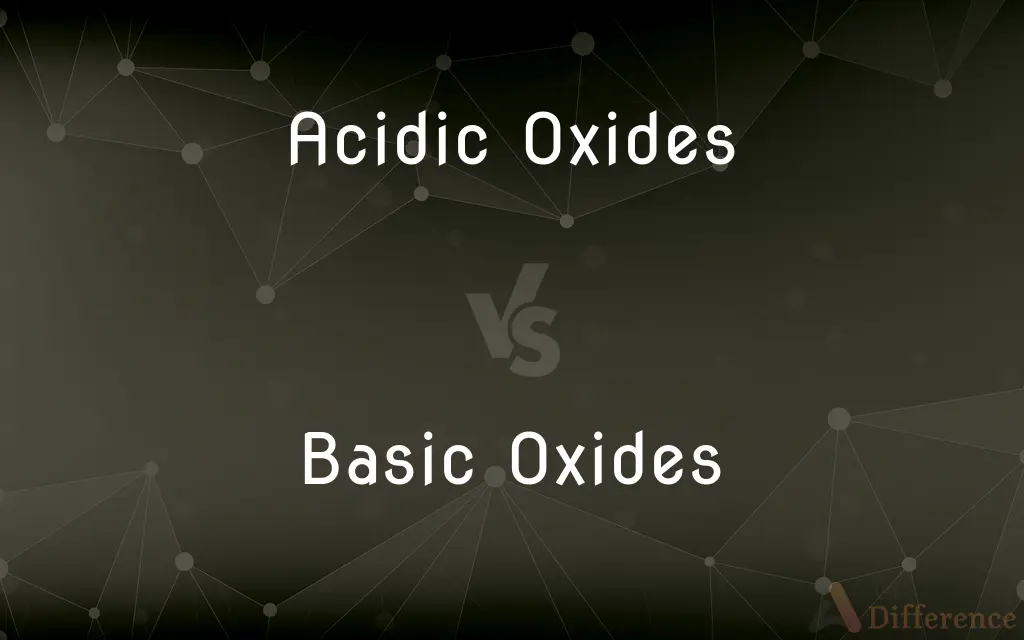Acidic Oxides vs. Basic Oxides — What's the Difference?
Edited by Tayyaba Rehman — By Fiza Rafique — Published on December 12, 2023
Acidic Oxides react with bases to form salts and water; Basic Oxides react with acids to produce the same results.

Difference Between Acidic Oxides and Basic Oxides
Table of Contents
ADVERTISEMENT
Key Differences
Acidic Oxides, often formed by non-metals, have the ability to react with bases, resulting in the formation of salts and water. Their acidic nature implies that they can donate protons or accept electron pairs during reactions. Conversely, Basic Oxides, which are predominantly produced by metals, possess the intrinsic nature to combine with acids, again leading to the production of salts and water. These oxides, due to their basic properties, can accept protons or donate electron pairs.
When considering their formation, Acidic Oxides typically result from the oxidation of non-metals like sulfur or carbon. These oxides, when dissolved in water, can form acids. On the other hand, Basic Oxides form when metals undergo oxidation. A characteristic feature of Basic Oxides is their ability to dissolve in water to produce a base.
From a chemical behavior perspective, Acidic Oxides display properties that allow them to neutralize bases. An example to illustrate this would be the reaction between sulfur dioxide (an acidic oxide) and sodium hydroxide. In contrast, Basic Oxides exhibit a penchant for neutralizing acids. For instance, calcium oxide (a basic oxide) reacts with hydrochloric acid to form calcium chloride and water.
In the environment, the presence of Acidic Oxides, especially those like sulfur dioxide and nitrogen oxides, can contribute to acid rain, a phenomenon detrimental to ecosystems. Basic Oxides, while less frequently discussed in environmental contexts, can also impact environmental pH levels when released in large quantities.
Chemically, both Acidic Oxides and Basic Oxides play crucial roles in various reactions. Their behavior, dictated by their acidic or basic nature, ensures that they participate in neutralization reactions, yielding salts and water as primary products.
ADVERTISEMENT
Comparison Chart
Origin
Formed by non-metals
Formed by metals
Reaction with Water
Forms acids
Forms bases
Reaction Type
Reacts with bases
Reacts with acids
Environmental Impact
Can contribute to acid rain
Can affect environmental pH levels
Proton Behavior
Donates protons or accepts electron pairs
Accepts protons or donates electron pairs
Compare with Definitions
Acidic Oxides
Compounds resulting from the oxidation of non-metals.
Upon combustion, phosphorus forms Acidic Oxides like P4O10.
Basic Oxides
Oxides that exhibit basic properties upon interaction with acids.
Sodium oxide, one of the Basic Oxides, forms sodium hydroxide in water.
Acidic Oxides
Oxides that exhibit acidic properties when interacting with bases.
Sulfur dioxide, one of the Acidic Oxides, forms sulfurous acid in water.
Basic Oxides
Compounds formed due to the oxidation of metals.
When exposed to oxygen, aluminum forms Basic Oxides like Al2O3.
Acidic Oxides
Non-metallic oxides reacting with bases to form salts.
Carbon dioxide is an Acidic Oxide that reacts with calcium hydroxide in water.
Basic Oxides
Oxides dissolving in water to produce a base.
Calcium oxide, a Basic Oxide, forms calcium hydroxide in water.
Acidic Oxides
Oxides that can form acids when dissolved in water.
Nitrogen dioxide, an Acidic Oxide, forms nitric acid upon dissolution.
Basic Oxides
Metallic oxides that can react with acids to form salts.
Magnesium oxide is a Basic Oxide that reacts with hydrochloric acid.
Acidic Oxides
Proton donors or electron pair acceptors in reactions.
When in water, many Acidic Oxides increase the solution's acidity.
Basic Oxides
Proton acceptors or electron pair donors in reactions.
In aqueous solutions, Basic Oxides typically increase the solution's pH.
Common Curiosities
How are Acidic Oxides typically formed?
Acidic Oxides are usually formed by the oxidation of non-metals.
Are Acidic Oxides harmful to the environment?
Yes, some Acidic Oxides like sulfur dioxide can contribute to acid rain.
What's the primary difference between Acidic Oxides and Basic Oxides?
Acidic Oxides react with bases to form salts, while Basic Oxides react with acids to yield salts.
What is a common environmental concern related to Acidic Oxides?
A common concern is acid rain, which can be caused by certain Acidic Oxides.
Which type of oxide would you expect metals like magnesium to form?
Metals like magnesium typically form Basic Oxides.
Do Basic Oxides show properties of acids or bases?
Basic Oxides show properties of bases.
Which oxide would react with hydrochloric acid to form a salt?
Basic Oxides would react with hydrochloric acid to form a salt.
In a reaction between an oxide and an acid, which oxide type would you expect?
In such a reaction, you would expect Basic Oxides.
Can Basic Oxides neutralize Acidic Oxides?
Yes, Basic Oxides can react with Acidic Oxides in neutralization reactions.
What happens when Basic Oxides dissolve in water?
When Basic Oxides dissolve in water, they often form bases.
Can Acidic Oxides increase the acidity of a solution?
Yes, Acidic Oxides can increase the acidity when dissolved in a solution.
Can Basic Oxides increase the alkalinity of a solution?
Yes, Basic Oxides can increase the alkalinity when dissolved in a solution.
What type of oxide would sulfur dioxide be classified as?
Sulfur dioxide is classified as an Acidic Oxide.
How do Basic Oxides generally react with water?
Basic Oxides typically dissolve in water to produce bases.
Are Acidic Oxides typically formed by metals or non-metals?
Acidic Oxides are typically formed by non-metals.
Share Your Discovery

Previous Comparison
Temporal Summation vs. Spatial Summation
Next Comparison
Potato Puree vs. Mashed PotatoesAuthor Spotlight
Written by
Fiza RafiqueFiza Rafique is a skilled content writer at AskDifference.com, where she meticulously refines and enhances written pieces. Drawing from her vast editorial expertise, Fiza ensures clarity, accuracy, and precision in every article. Passionate about language, she continually seeks to elevate the quality of content for readers worldwide.
Edited by
Tayyaba RehmanTayyaba Rehman is a distinguished writer, currently serving as a primary contributor to askdifference.com. As a researcher in semantics and etymology, Tayyaba's passion for the complexity of languages and their distinctions has found a perfect home on the platform. Tayyaba delves into the intricacies of language, distinguishing between commonly confused words and phrases, thereby providing clarity for readers worldwide.












































